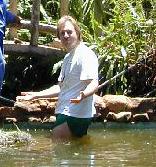
Replanting the Pond
at the Department of Botany,
University of Pretoria, South Africa
By Jacques Gerber - Click images to
enlarge
When I came to the University of Pretoria in 2001, I discovered
that the departmental pond was in a shocking state. Water level
fluctuated, and the waterlilies (all non-indigenous hardies)
were planted at a depth of 10cm. The fish population consisted
of 10 or so large Cyprinids (some goldfish, carp and a single
koi). I managed to convince the garden committee that the pond
was in serious need of a replant. Finally in September 2002,
the project went ahead. The pond was pumped dry and the large
fish caught.

|
Turned out there was also a sizeable population of Southern Mouth
Brooders in the pond, and these pictures show myself and Andre
Grobler, a colleague of mine in the Plant Ecology Unit, trying
to rescue as many of these as possible. We managed to rescue
over 200, and for the next three weeks they made a complete mess
of my aquaria. |

|
|
The pond was built some time during the 1950's. The bottom is
concrete, and the sidewalls are brick. At some point it was painted
blue like a swimming pool. Plants were in pots, scattered around
the pond on pillars. Roots from surrounding trees had broken
through the brick wall in places, and two cycads that were planted
to close to the pond had actually cracked the shell. In some
places the sludge in the dam was two feet thick. We moved the
worst offender of the two cycads, a large Encephalartos transvenosis,
chopped out and filled the cracks, and built planting platforms
in places around the pond sides. This is far from the best way
to do it, but funds were short - very short. All the plants,
with the exception of a Sauraurus cernua, were repotted,
and just as well. None of them were planted in soil, only aquarium
gravel! This was remedied.
Only one of the old waterlilies was retained, and this turned
out to be a magenta flowered hardy. It's interesting that the
main nurseries in South Africa that stock aquatics are in areas
that are generally too cold for tropicals. It's warm enough here
in Pretoria, but the nurseries here don't even have N. capensis,
only hardies. Our latitude is approximately that of south Florida.
We managed to purchase three Nymphaea capensis (Cape
Blue Waterlilies), several Aponogeton distachys (Water
Hawthorn or Waterblommetjie) and a Nymphoides indica (Pond
Fringe). Marginal plants include Cyperus papyrus var.
nana, Persicaria lapathifolia, Persicaria amphibia,
Ranuculus mutifidus, and Cyperus immensis. |

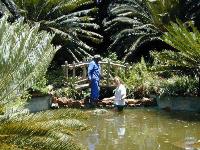 |
The pond was then refilled and turned out to leak like
a sieve. The pictures at the left show myself and Peter Shabangu,
one of the garden staff, building a leak containment wall across
the stream leading to the waterfall. Although the pond is meant
to be Peter's responsibility, he now refuses to maintain it,
so I do instead, not that I get paid...The wall worked, and the
pond now only loses 2.5 kilolitres per day instead of 7 kilolitres.
This is really still too much, but it has to do for now. We figure
the trees are using the water.
The rest of the pictures, below, show myself and my student
Retief Grobler (no relation to Andre) planting plants I collected
at Rust de Winter Dam, including the Nymphaea caerulea.
Other plants put in that day were Typha capensis, and
Najas horridus, as well as several members of the Scrophulaceae,
a Potamogeton species,and a Schoenoplectus species.
Kit Knotts has provided us with a |
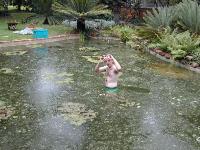 |
number of night blooming tropical cultivars which arrived
the morning I wrote this. In case you're wondering why I'm wearing
a diving mask - I wanted to count the number of flower buds on
the waterlilies, and the water is a bit murky from above. |
 |
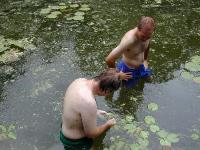 |
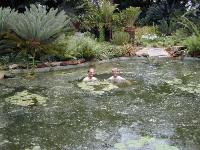 |
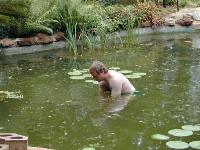 |
Right now the waterlilies are doing well, as are most of the
other plants. The night bloomers have been planted, and I hope
for good things from them. Plans for 2003 are hopefully to empty
the pond again, replaster and waterproof the shell properly,
build planting ledges in the pond from rubble and concrete, and
then waterproof these as well. This should make the pond reasonably
waterproof, and provide a double layer of protection. The planting
ledges will permit planting directly into soil instead of in
pots. Plans include a large shallow area for Nelumbo nucifera
(Lotuses), and a bog garden for delights such as Gunnera perpensa,
Ranunculus multifidus, and other wetland plants that don't
like being under water. The deep part of the pond will be planted
with pots to make maintenance easier. We will include pink Nymphaea
capensis, Nymphaea lotus (which flowers during the
day here - go figure!) and hopefully Nymphaea petersiana.
That will give us the full spectrum of native South African waterlilies.
Profile
- Jacques Gerber | The
Pond January 2003
|









